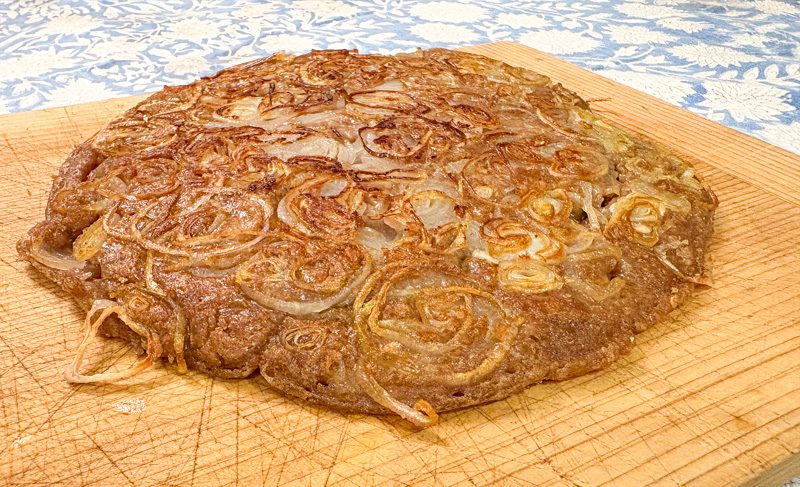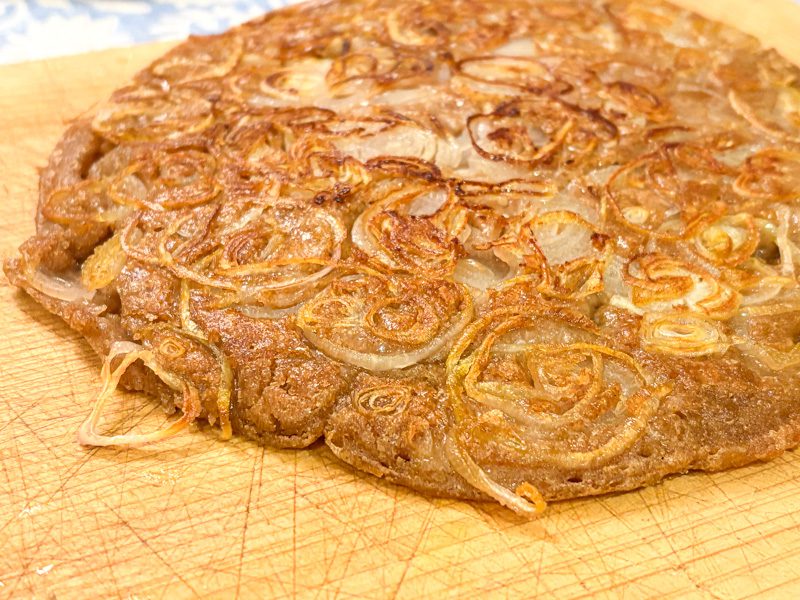If you have sourdough starter and a shallot (or onion) lying around . . . here’s a quick sourdough discard flatbread recipe that requires no advance planning and is done in about 20 minutes!

What is Sourdough Discard?
Sourdough relies on wild yeast and beneficial bacteria from the environment to rise, rather than packaged yeast like most other commercial breads. To cultivate the yeast for sourdough, you combine a small amount of flour and water and allow it to ferment over several days. The fermented mixture is called a sourdough starter. The starter is added at the beginning of the breadmaking process instead of packaged yeast.
To keep a sourdough starter healthy, bakers regularly remove half of the mixture (the discard) and feed the remainder with a mixture of fresh flour and water. The discarded portion isn’t active enough to use for a loaf of bread, but it has enough rise for this flatbread and provides a delicious, tangy flavor.
If you’re new to sourdough, here’s a great article about how to make sourdough starter. I also highly recommend the Tartine Bread book, which has been our home’s go-to sourdough handbook. Excellent pictures, instructions, and recipes. We’ve been doing variations of the primary recipe for sourdough in that book for years now, with great results.
FYI – I use 100% stone ground whole wheat flour for my starter. You can find way too much information about why I use stone ground whole wheat in this post, if you’re curious.
Once you have a sourdough starter, you can quickly make a sourdough discard flatbread without the rising, folding, and prep required to make a full sourdough loaf. It means we can have fresh, hot flatbread as a side at dinner, and it takes very little effort. One of our favorite sourdough discard flatbreads is this caramelized onion version.

Why So Much Sourdough Starter Lying Around?
To use starter to make a loaf of sourdough bread, you must train it to expect a daily or even twice-daily feeding for at least a couple of days before you use it for your sourdough. Otherwise, the yeast won’t be active enough to make the loaf rise well. This means you can’t just make a starter and then keep it in the fridge until the day you want to use it.
I tried keeping our starter in the fridge for a period (you can do this and reduce feedings to weekly without hurting the starter – it just gets less active), but then I would want to make bread and would realize that I couldn’t do that for at least 2-3 days. First I’d need to take the starter back out to our kitchen counter and resume daily feedings. So for a while, I pretty much stopped making bread. No good.
So I decided to keep the starter on my kitchen counter and feed it every day so I can make bread whenever I want. But then I was throwing away a lot of sourdough starter with every feeding. So I started experimenting with ways to it up.
How to Use Sourdough Discard
I feed my sourdough starter in the evenings – so I usually have some discard to use up around dinner time.
This recipe calls for 1/3 of a cup of starter in an 8 inch frying pan. If you want to increase the size of the flatbread, you need 1/2 of a cup for a 10 inch pan, or 3/4 of a cup in a 12 inch pan. There are two ways you can go about getting this amount of starter.
Option 1: You can just pour off the discard into a Tupperware. Hoard starter discard in the Tupperware in the fridge until you’re ready to use it.
Option 2, my preferred method: Instead of throwing away about 50% of my starter each day, I don’t throw away anything. I add enough water and flour to feed the starter so that it’s a little more than doubled in size. For example, if I start with 1/2 cup of unfed starter, I’ll just add about 1/3 cup water plus 1/4 cup whole wheat flour so that I have a little more than 1 cup of starter when I’m finished. (I add a little more water than flour because I like to keep my starter on the liquid side, like pancake batter). I usually eyeball the measurements.
In option 2, I quickly accumulate starter – so I use it several times a week in sourdough discard recipes like this sourdough discard flatbread recipe.
Now, on to the recipe.
Print
Quick Caramelized Onion Flatbread
I came up with this sourdough discard flatbread because I was throwing away a lot of starter every time I fed it. I needed to find something else to make instead of discarding half of my starter every feeding, and this flatbread very little effort but a hit with the kids. It’s hot bread after all! (But it’s also 100% whole wheat!)
Equipment: 8-inch nonstick skillet (bigger, if you increase the recipe size)
Note on increasing the recipe size: For an 8″ flatbread, I use an 8 inch frying pan and 1/3 cup starter. This is the recipe you’ll see below.
To increase the size of the flatbread, use 1/2 of a cup of starter (and 2 shallots, 2.5 tbsp olive oil) for a 10 inch pan, or 3/4 of a cup (and 3 shallots, 3.5 tbsp olive oil) in a 12 inch pan.
- Total Time: 20 minutes
- Yield: 1 flatbread 1x
Ingredients
2 tbsp olive oil
1/3 cup unfed sourdough starter
1 large shallot, thinly sliced
1 tbsp Za’atar (optional)
Instructions
1. Prepare the skillet.
See my note above about how much starter to use if you want a larger flatbread.
Distribute the 1 tbsp of olive oil as evenly as possible in a nonstick skillet that has a cover. I will usually spray it in (with my glass olive oil spray bottle, 1 tbsp is about 12-18 squirts) for this reason. Preheat for about 30 seconds over medium-low heat. Sprinkle the olive oil with some salt.
Note: You could use a cast iron or carbon steel skillet, but the heat distribution & nonstick properties will not be as good so this may be more challenging. If you’re determined nevertheless, consider using extra olive oil and preheating for at least 3 minutes.
2. Add the starter.
Drizzle the 1/3 cup of unfed sourdough starter directly into the olive oil and all around the pan as evenly as possible. If you need you can swirl it around in the pan to get it into a more even layer. My starter is usually about the consistency of a slightly runny pancake batter, so this makes this drizzling step fairly simple. If you’re struggling, your mixture may be a bit thick, so you may want to use a spoon to help you out.
Sprinkle the starter with salt. Leave the heat on medium-low.

3. Add the shallot / onion
While the starter begins to cook, thinly slice a shallot or onion until you have 2-3 tbsp of thinly sliced shallot/onion. Break them up a bit and generously sprinkle them over the starter.
Sprinkle everything again with some salt. Cover and reduce the heat to very low. Cook for 8 minutes covered.

2. Remove the cover and let cook for 2-3 more minutes.
This step is needed because the bread can sometimes get a bit soggy while covered. Covering it helps you get as much rise out of the flatbread as you can, but it also makes it very delicate. If the bread still feels very fragile or doughy after 2-3 minutes of uncovered cooking time, give it another couple minutes before you try to flip it. Below is how mine looked when it was ready to flip.
3. Flip the flatbread over. Cook uncovered for 10 more minutes.
After flipping, drizzle 1 tbsp of olive oil around the outside edges of the flatbread. The heat level is correct if you begin to see the olive oil sizzle around the bread within about 15 seconds. If not, adjust your heat accordingly. You want a gentle sizzle going during this 10 minutes to ensure the onions caramelize but do not burn.

4. After 10 minutes, peek under the flatbread to see if the onion looks caramelized.
It can be difficult to peek under the flatbread, so sometimes I just grab my wooden cutting board and put it next to the stove. I grab my pan and flip the flatbread down directly onto the cutting board. So the flatbread comes out onto the cutting board with the onion side up. If the onion hasn’t picked up much color, return the flatbread to the pan, onion side down, and turn the heat up slightly. Let it cook for 2-3 more minutes.
5. Remove from heat.
Flip the flatbread onto a wooden cutting board, onion side up.

6. Sprinkle with za’atar (if you so desire), and enjoy!

- Cook Time: 20 min
- Category: Dinner
- Method: stovetop



